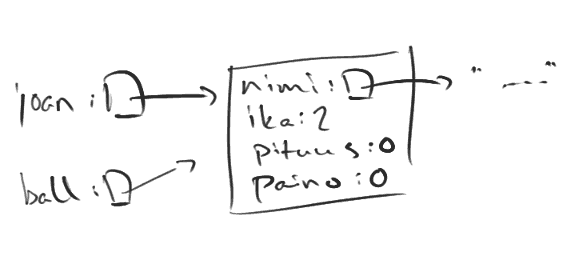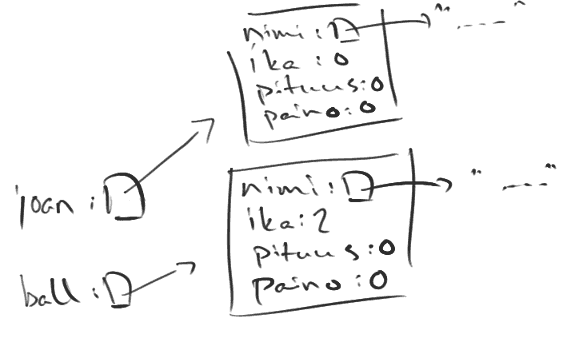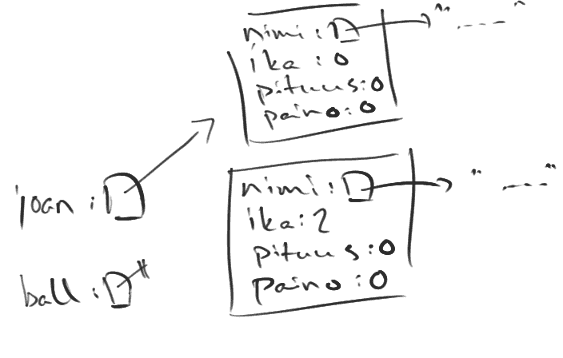Objects and references
Let's continue working with objects and references. Assume we can use the class that represents a person, shown below. Person has object variables name, age, weight and height. Additionally, it contains methods to calculate the body mass index, among other things.
public class Person {
private String name;
private int age;
private int weight;
private int height;
public Person(String name) {
this(name, 0, 0, 0);
}
public Person(String name, int age, int height, int weight) {
this.name = name;
this.age = age;
this.weight = weight;
this.height = height;
}
// other constructors and methods
public String getName() {
return this.name;
}
public int getAge() {
return this.age;
}
public int getHeight() {
return this.height;
}
public void growOlder() {
this.age = this.age + 1;
}
public void setHeight(int newHeight) {
this.height = newHeight;
}
public void setWeight(int newWeight) {
this.weight = newWeight;
}
public double bodyMassIndex() {
double heightPerHundred = this.height / 100.0;
return this.weight / (heightPerHundred * heightPerHundred);
}
@Override
public String toString() {
return this.name + ", age " + this.age + " years";
}
}Precisely what happens when a new object is created?
Person joan = new Person("Joan Ball");Calling a constructor with the command new causes several things to happen. First, space is reserved in the computer memory for storing object variables. Then default or initial values are set to object variables (e.g. an int type variable receives an initial value of 0). Lastly, the source code in the constructor is executed.
A constructor call returns a reference to an object. A reference is information about the location of object data.

So the value of the variable is set to be a reference, i.e. knowledge about the location of related object data. The image above also reveals that strings — the name of our example person, for instance — are objects, too.
Assigning a reference type variable copies the reference
Let's add a Person type variable called ball into the program, and assign joan as its initial value. What happens then?
Person joan = new Person("Joan Ball");
System.out.println(joan);
Person ball = joan;The statement Person ball = joan; creates a new Person variable ball, and copies the value of the variable joan as its value. As a result, ball refers to the same object as joan.

Let's inspect the same example a little more thoroughly.
Person joan = new Person("Joan Ball");
System.out.println(joan);
Person ball = joan;
ball.growOlder();
ball.growOlder();
System.out.println(joan);Joan Ball, age 0 years Joan Ball, age 2 years
Joan Ball — i.e. the Person object that the reference in the joan variable points at — starts as 0 years old. After this the value of the joan variable is assigned (so copied) to the ball variable. The Person object ball is aged by two years, and Joan Ball ages as a consequence!
An object's internal state is not copied when a variable's value is assigned. A new object is not being created in the statement Person ball = joan; — the value of the variable ball is assigned to be the copy of joan's value, i.e. a reference to an object.

Next, the example is continued so that a new object is created for the joan variable, and a reference to it is assigned as the value of the variable. The variable ball still refers to the object that we created earlier.
Person joan = new Person("Joan Ball");
System.out.println(joan);
Person ball = joan;
ball.growOlder();
ball.growOlder();
System.out.println(joan);
joan = new Person("Joan B.");
System.out.println(joan);The following is printed:
Joan Ball, age 0 years Joan Ball, age 2 years Joan B., age 0 years
So in the beginning the variable joan contains a reference to one object, but in the end a reference to another object has been copied as its value. Here is a picture of the situation after the last line of code.

null value of a reference variable
Let's extend the example further by setting the value of the reference variable ball to null, i.e. a reference "to nothing". The null reference can be set as the value of any reference type variable.
Person joan = new Person("Joan Ball");
System.out.println(joan);
Person ball = joan;
ball.growOlder();
ball.growOlder();
System.out.println(joan);
joan = new Person("Joan B.");
System.out.println(joan);
ball = null;The situation of the program after the last line is depicted below.

The object whose name is Joan Ball is referred to by nobody. In other words, the object has become "garbage". In the Java programming language the programmer need not worry about the program's memory use. From time to time, the automatic garbage collector of the Java language cleans up the objects that have become garbage. If the garbage collection did not happen, the garbage objects would reserve a memory location until the end of the program execution.
Let's see what happens when we try to print a variable that references "nothing" i.e. null.
Person joan = new Person("Joan Ball");
System.out.println(joan);
Person ball = joan;
ball.growOlder();
ball.growOlder();
System.out.println(joan);
joan = new Person("Joan B.");
System.out.println(joan);
ball = null;
System.out.println(ball);Joan Ball, age 0 years Joan Ball, age 2 years Joan B., age 0 years null
Printing a null reference prints "null". How about if we were to try and call a method, say growOlder, on an object that refers to nothing:
Person joan = new Person("Joan Ball");
System.out.println(joan);
joan = null;
joan.growOlder();The result:
Joan Ball, age 0 years Exception in thread "main" java.lang.NullPointerException at Main.main(Main.java:(row)) Java Result: 1
Bad things follow. This could be the first time you have seen the text NullPointerException. In the course of the program, there occured an error indicating that we called a method on a variable that refers to nothing.
We promise that this is not the last time you will encounter the previous error. When you do, the first step is to look for variables whose value could be null. Fortunately, the error message is useful: it tells which row caused the error. Try it out yourself!
Object as a method parameter
We have seen both primitive and reference variables act as method parameters. Since objects are reference variables, any type of object can be defined to be a method parameter. Let's take a look at a practical demonstration.
Amusement park rides only permit people who are taller than a certain height. The limit is not the same for all attractions. Let's create a class representing an amusement park ride. When creating a new object, the constructor receives as parameters the name of the ride, and the smallest height that permits entry to the ride.
public class AmusementParkRide {
private String name;
private int lowestHeight;
public AmusementParkRide(String name, int lowestHeight) {
this.name = name;
this.lowestHeight = lowestHeight;
}
public String toString() {
return this.name + ", minimum height: " + this.lowestHeight;
}
}Then let's write a method that can be used to check if a person is allowed to enter the ride, so if they are tall enough. The method returns true if the person given as the parameter is permitted access, and false otherwise.
Below, it is assumed that Person has the method public int getHeight() that returns the height of the person.
public class AmusementParkRide {
private String name;
private int lowestHeight;
public AmusementParkRide(String name, int lowestHeight) {
this.name = name;
this.lowestHeight = lowestHeight;
}
public boolean allowedToRide(Person person) {
if (person.getHeight() < this.lowestHeight) {
return false;
}
return true;
}
public String toString() {
return this.name + ", minimum height: " + this.lowestHeight;
}
}So the method allowedToRide of an AmusementParkRide object is given a Person object as a parameter. Like earlier, the value of the variable — in this case, a reference — is copied for the method to use. The method handles a copied reference, and it calls the getHeight method of the person passed as a parameter.
Below is an example main program where the amusement park ride method is called twice: first the supplied parameter is a person object matt, and then a person object jasper:
Person matt = new Person("Matt");
matt.setWeight(86);
matt.setHeight(180);
Person jasper = new Person("Jasper");
jasper.setWeight(34);
jasper.setHeight(132);
AmusementParkRide waterTrack = new AmusementParkRide("Water track", 140);
if (waterTrack.allowedToRide(matt)) {
System.out.println(matt.getName() + " may enter the ride");
} else {
System.out.println(matt.getName() + " may not enter the ride");
}
if (waterTrack.allowedToRide(jasper)) {
System.out.println(jasper.getName() + " may enter the ride");
} else {
System.out.println(jasper.getName() + " may not enter the ride");
}
System.out.println(waterTrack);The output of the program is:
Matt may enter the ride Jasper may not enter the ride Water track, minimum height: 140
What if we wanted to know how many people have taken the ride?
Let's add an object variable to the amusement park ride. It keeps track of the number of people that were permitted to enter.
public class AmusementParkRide {
private String name;
private int lowestHeight;
private int visitors;
public AmusementParkRide(String name, int lowestHeight) {
this.name = name;
this.lowestHeight = lowestHeight;
this.visitors = 0;
}
public boolean allowedToRide(Person person) {
if (person.getHeight() < this.lowestHeight) {
return false;
}
this.visitors++;
return true;
}
public String toString() {
return this.name + ", minimum height: " + this.lowestHeight +
", visitors: " + this.visitors;
}
}Now the previously used example program also keeps track of the number of visitors who have experienced the ride.
Person matt = new Person("Matt");
matt.setWeight(86);
matt.setHeight(180);
Person jasper = new Person("Jasper");
jasper.setWeight(34);
jasper.setHeight(132);
AmusementParkRide waterTrack = new AmusementParkRide("Water track", 140);
if (waterTrack.allowedToRide(matt)) {
System.out.println(matt.getName() + " may enter the ride");
} else {
System.out.println(matt.getName() + " may not enter the ride");
}
if (waterTrack.allowedToRide(jasper)) {
System.out.println(jasper.getName() + " may enter the ride");
} else {
System.out.println(jasper.getName() + " may not enter the ride");
}
System.out.println(waterTrack);The output of the program is:
Matt may enter the ride Jasper may not enter the ride Water track, minimum height: 140, visitors: 1
Object as object variable
Objects may contain references to objects.
Let's keep working with people, and add a birthday to the person class. A natural way of representing a birthday is to use a Date class. We could use the classname Date, but for the sake of avoiding confusion with the similarly named existing Java class, we will use SimpleDate here.
public class SimpleDate {
private int day;
private int month;
private int year;
public SimpleDate(int day, int month, int year) {
this.day = day;
this.month = month;
this.year = year;
}
public int getDay() {
return this.day;
}
public int getMonth() {
return this.month;
}
public int getYear() {
return this.year;
}
@Override
public String toString() {
return this.day + "." + this.month + "." + this.year;
}
}Since we know the birthday, there is no need to store that age of a person as a separate object variable. The age of the person can be inferred from their birthday. Let's assume that the class Person now has the following variables.
public class Person {
private String name;
private SimpleDate birthday;
private int weight = 0;
private int length = 0;
// ...Let's create a new Person constructor that allows for setting the birthday:
public Person(String name, SimpleDate date) {
this.name = name;
this.birthday = date;
}Along with the constructor above, we could give Person another constructor where the birthday was given as integers.
public Person(String name, int day, int month, int year) {
this.name = name;
this.birthday = new SimpleDate(day, month, year);
}The constructor receives as parameters the different parts of the date (day, month, year). They are used to create a date object, and finally the reference to that date is copied as the value of the object variable birthday.
Let's modify the toString method of the Person class so that instead of age, the method returns the birthday:
public String toString() {
return this.name + ", born on " + this.birthday;
}Let's see how the updated Person class works.
SimpleDate date = new SimpleDate(1, 1, 780);
Person muhammad = new Person("Muhammad ibn Musa al-Khwarizmi", date);
Person pascal = new Person("Blaise Pascal", 19, 6, 1623);
System.out.println(muhammad);
System.out.println(pascal);Muhammad ibn Musa al-Khwarizmi, born on 1.1.780 Blaise Pascal, born on 19.6.1623
Now a person object has object variables name and birthday. The variable name is a string, which itself is an object; the variable birthday is a SimpleDate object.
Both variables contain a reference to an object. Therefore a person object contains two references. In the image below, weight and height are not considered at all.

So the main program is connected to two Person objects by strands. A person has a name and a birthday. Since both variables are objects, these attributes exist at the other ends of the strands.
Birthday appears to be a good extension to the Person class. Earlier we noted that the object variable age can be calculated with birthday, so it was removed.
Object of same type as method parameter
We will continue working with the Person class. We recall that persons know their birthdays:
public class Person {
private String name;
private SimpleDate birthday;
private int height;
private int weight;
// ...
}We would like to compare the ages of two people. The comparison can be done in multiple ways. We could, for instance, implement a method called public int ageAsYears() for the Person class; in that case, the comparison would happen in the following manner:
Person muhammad = new Person("Muhammad ibn Musa al-Khwarizmi", 1, 1, 780);
Person pascal = new Person("Blaise Pascal", 19, 6, 1623);
if (muhammad.ageAsYears() > pascal.ageAsYears()) {
System.out.println(muhammad.getName() + " is older than " + pascal.getName());
}We are now going to learn a more "object-oriented" way to compare the ages of people.
We are going to create a new method boolean olderThan(Person compared) for the Person class. It can be used to compare a certain person object to the person supplied as the parameter based on their ages.
The method is meant to be used like this:
Person muhammad = new Person("Muhammad ibn Musa al-Khwarizmi", 1, 1, 780);
Person pascal = new Person("Blaise Pascal", 19, 6, 1623);
if (muhammad.olderThan(pascal)) { // same as muhammad.olderThan(pascal)==true
System.out.println(muhammad.getName() + " is older than " + pascal.getName());
} else {
System.out.println(muhammad.getName() + " is not older than " + pascal.getName());
}The program above asks if al-Khwarizmi is older than Pascal. The method olderThan returns true if the object that is used to call the method (object.olderThan(objectGivenAsParameter)) is older than the object given as the parameter, and false otherwise.
In practice, we call the olderThan method of the object that matches "Muhammad ibn Musa al-Khwarizmi", which is referred to by the variable muhammad. The reference pascal, matching the object "Blaise Pascal", is given as the parameter to that method.
The program prints:
Muhammad ibn Musa al-Khwarizmi is older than Blaise Pascal
The method olderThan receives a person object as its parameter. More precisely, the variable that is defined as the method parameter receives a copy of the value contained by the given variable. That value is a reference to an object, in this case.
The implementation of the method is illustrated below. Note that the method may return a value in more than one place — here the comparison has been divided into multiple parts based on the years, the months, and the days:
public class Person {
// ...
public boolean olderThan(Person compared) {
// 1. First compare years
int ownYear = this.getBirthday().getYear();
int comparedYear = compared.getBirthday().getYear();
if (ownYear < comparedYear) {
return true;
}
if (ownYear > comparedYear) {
return false;
}
// 2. Same birthyear, compare months
int ownMonth = this.getBirthday().getMonth();
int comparedMonth = compared.getBirthday().getMonth();
if (ownMonth < comparedMonth) {
return true;
}
if (ownMonth > comparedMonth) {
return false;
}
// 3. Same birth year and month, compare days
int ownDay = this.getBirthday().getDay();
int comparedDay = compared.getBirthday().getDay();
if (ownDay < comparedDay) {
return true;
}
return false;
}
}Let's pause for a moment to consider abstraction, one of the principles of object-oriented programming. The idea behind abstraction is to conceptualize the programming code so that each concept has its own clear responsibilities. When viewing the solution above, however, we notice that the comparison functionality would be better placed inside the SimpleDate class instead of the Person class.
We'll create a method called public boolean before(SimpleDate compared) for the class SimpleDate. The method returns the value true if the date given as the parameter is after (or on the same day as) the date of the object whose method is called.
public class SimpleDate {
private int day;
private int month;
private int year;
public SimpleDate(int day, int month, int year) {
this.day = day;
this.month = month;
this.year = year;
}
public String toString() {
return this.day + "." + this.month + "." + this.year;
}
// used to check if this date object (`this`) is before
// the date object given as the parameter (`compared`)
public boolean before(SimpleDate compared) {
// first compare years
if (this.year < compared.year) {
return true;
}
if (this.year > compared.year) {
return false;
}
// years are same, compare months
if (this.month < compared.month) {
return true;
}
if (this.month > compared.month) {
return false;
}
// years and months are same, compare days
if (this.day < compared.day) {
return true;
}
return false;
}
}Even though the object variables year, month, and day are encapsulated (private) object variables, we can read their values by writing compared.*variableName*. This is because a private variable can be accessed from all the methods contained by that class. Notice that the syntax here matches calling some object method. Unlike when calling a method, we refer to a field of an object, so the parentheses that indicate a method call are not written.
An example of how to use the method:
public static void main(String[] args) {
SimpleDate d1 = new SimpleDate(14, 2, 2011);
SimpleDate d2 = new SimpleDate(21, 2, 2011);
SimpleDate d3 = new SimpleDate(1, 3, 2011);
SimpleDate d4 = new SimpleDate(31, 12, 2010);
System.out.println(d1 + " is earlier than " + d2 + ": " + d1.before(d2));
System.out.println(d2 + " is earlier than " + d1 + ": " + d2.before(d1));
System.out.println(d2 + " is earlier than " + d3 + ": " + d2.before(d3));
System.out.println(d3 + " is earlier than " + d2 + ": " + d3.before(d2));
System.out.println(d4 + " is earlier than " + d1 + ": " + d4.before(d1));
System.out.println(d1 + " is earlier than " + d4 + ": " + d1.before(d4));
}14.2.2011 is earlier than 21.2.2011: true 21.2.2011 is earlier than 14.2.2011: false 21.2.2011 is earlier than 1.3.2011: true 1.3.2011 is earlier than 21.2.2011: false 31.12.2010 is earlier than 14.2.2011: true 14.2.2011 is earlier than 31.12.2010: false
Let's tweak the method olderThan of the Person class so that from here on out, we take use of the comparison functionality that date objects provide.
public class Person {
// ...
public boolean olderThan(Person compared) {
if (this.birthday.before(compared.getBirthday())) {
return true;
}
return false;
// or return more directly:
// return this.birthday.before(compared.getBirthday());
}
}Now the concrete comparison of dates is implemented in the class that it logically (based on the class names) belongs to.
Comparing the equality of objects (equals)
While working with strings, we learned that strings must be compared using the equals method. This is how it's done.
Scanner scanner = new Scanner(System.in);
System.out.println("Enter two words, each on its own line.")
String first = scanner.nextLine();
String second = scanner.nextLine();
if (first.equals(second)) {
System.out.println("The words were the same.");
} else {
System.out.println("The words were not the same.");
}With primitive variables such as int, comparing two variables can be done with two equality signs. This is because the value of a primitive variable is stored directly in the "variable's box". The value of reference variables, in contrast, is an address of the object that is referenced; so the "box" contains a reference to the memory location. Using two equality signs compares the equality of the values stored in the "boxes of the variables" — with reference variables, such comparisons would examine the equality of the memory references.
The method equals is similar to the method toString in the respect that it is available for use even if it has not been defined in the class. The default implementation of this method compares the equality of the references. Let's observe this with the help of the previously written SimpleDate class.
SimpleDate first = new SimpleDate(1, 1, 2000);
SimpleDate second = new SimpleDate(1, 1, 2000);
SimpleDate third = new SimpleDate(12, 12, 2012);
SimpleDate fourth = first;
if (first.equals(first)) {
System.out.println("Variables first and first are equal");
} else {
System.out.println("Variables first and first are not equal");
}
if (first.equals(second)) {
System.out.println("Variables first and second are equal");
} else {
System.out.println("Variables first and second are not equal");
}
if (first.equals(third)) {
System.out.println("Variables first and third are equal");
} else {
System.out.println("Variables first and third are not equal");
}
if (first.equals(fourth)) {
System.out.println("Variables first and fourth are equal");
} else {
System.out.println("Variables first and fourth are not equal");
}Variables first and first are equal Variables first and second are not equal Variables first and third are not equal Variables first and fourth are equal
There is a problem with the program above. Even though two dates (first and second) have exactly the same values for object variables, they are different from each other from the point of view of the default equals method.
If we want to be able to compare two objects of our own design with the equals method, that method must be defined in the class. The method equals is defined as a method that returns a boolean type value — the return value indicates whether the objects are equal.
The equals method is implemented in such a way that it can be used to compare the current object with any other object. The method receives an Object-type object as its single parameter — all objects are Object-type, in addition to their own type. The equals method first compares if the addresses are equal: if so, the objects are equal. After this, we examine if the types of the objects are the same: if not, the objects are not equal. Next, the Object-type object passed as the parameter is converted to the type of the object that is being examined by using a type cast, so that the values of the object variables can be compared. Below the equality comparison has been implemented for the SimpleDate class.
public class SimpleDate {
private int day;
private int month;
private int year;
public SimpleDate(int day, int month, int year) {
this.day = day;
this.month = month;
this.year = year;
}
public int getDay() {
return this.day;
}
public int getMonth() {
return this.month;
}
public int getYear() {
return this.year;
}
public boolean equals(Object compared) {
// if the variables are located in the same position, they are equal
if (this == compared) {
return true;
}
// if the type of the compared object is not SimpleDate, the objects are not equal
if (!(compared instanceof SimpleDate)) {
return false;
}
// convert the Object type compared object
// into a SimpleDate type object called comparedSimpleDate
SimpleDate comparedSimpleDate = (SimpleDate) compared;
// if the values of the object variables are the same, the objects are equal
if (this.day == comparedSimpleDate.day &&
this.month == comparedSimpleDate.month &&
this.year == comparedSimpleDate.year) {
return true;
}
// otherwise the objects are not equal
return false;
}
@Override
public String toString() {
return this.day + "." + this.month + "." + this.year;
}
}Building a similar comparison functionality is possible for Person objects too. Below, the comparison has been implemented for Person objects that don't have a separate SimpleDate object. Notice that the names of people are strings (i.e. objects), so we use the equals method for comparing them.
public class Person {
private String name;
private int age;
private int weight;
private int height;
// constructors and methods
public boolean equals(Object compared) {
// if the variables are located in the same position, they are equal
if (this == compared) {
return true;
}
// if the compared object is not of type Person, the objects are not equal
if (!(compared instanceof Person)) {
return false;
}
// convert the object into a Person object
Person comparedPerson = (Person) compared;
// if the values of the object variables are equal, the objects are equal
if (this.name.equals(comparedPerson.name) &&
this.age == comparedPerson.age &&
this.weight == comparedPerson.weight &&
this.height == comparedPerson.height) {
return true;
}
// otherwise the objects are not equal
return false;
}
// .. methods
}Object equality and lists
Let's examine how the equals method is used with lists. Let's assume we have the previously described class Bird without any equals method.
public class Bird {
private String name;
public Bird(String name) {
this.name = name;
}
}Let's create a list and add a bird to it. After this we'll check if that bird is contained in it.
ArrayList<Bird> birds = new ArrayList<>()
Bird red = new Bird("Red");
if (birds.contains(red)) {
System.out.println("Red is on the list.");
} else {
System.out.println("Red is not on the list.");
}
birds.add(red);
if (birds.contains(red)) {
System.out.println("Red is on the list.");
} else {
System.out.println("Red is not on the list.");
}
System.out.println("However!");
red = new Bird("Red");
if (birds.contains(red)) {
System.out.println("Red is on the list.");
} else {
System.out.println("Red is not on the list.");
}Red is not on the list. Red is on the list. However! Red is not on the list.
We can notice in the example above that we can search a list for our own objects. First, when the bird had not been added to the list, it is not found — and after adding it is found. When the program switches the red object into a new object, with exactly the same contents as before, it is no longer equal to the object on the list, and therefore cannot be found on the list.
The contains method of a list uses the equals method that is defined for the objects in its search for objects. In the example above, the Bird class has no definition for that method, so a bird with exactly the same contents — but a different reference — cannot be found on the list.
Let's implement the equals method for the class Bird. The method examines if the names of the objects are equal — if the names match, the birds are thought to be equal.
public class Bird {
private String name;
public Bird(String name) {
this.name = name;
}
public boolean equals(Object compared) {
// if the variables are located in the same position, they are equal
if (this == compared) {
return true;
}
// if the compared object is not of type Bird, the objects are not equal
if (!(compared instanceof Bird)) {
return false;
}
// convert the object to a Bird object
Bird comparedBird = (Bird) compared;
// if the values of the object variables are equal, the objects are, too
return this.name.equals(comparedBird.name);
/*
// the comparison of names above is equal to
// the following code
if (this.name.equals(comparedBird.name)) {
return true;
}
// otherwise the objects are not equal
return false;
*/
}
}Now the contains list method recognizes birds with identical contents.
ArrayList<Bird> birds = new ArrayList<>()
Bird red = new Bird("Red");
if (birds.contains(red)) {
System.out.println("Red is on the list.");
} else {
System.out.println("Red is not on the list.");
}
birds.add(red);
if (birds.contains(red)) {
System.out.println("Red is on the list.");
} else {
System.out.println("Red is not on the list.");
}
System.out.println("However!");
red = new Bird("Red");
if (birds.contains(red)) {
System.out.println("Red is on the list.");
} else {
System.out.println("Red is not on the list.");
}Red is not on the list. Red is on the list. However! Red is on the list.
Object as a method's return value
We have seen methods return boolean values, numbers, and strings. Easy to guess, a method can return an object of any type.
In the next example we present a simple counter that has the method clone. The method can be used to create a clone of the counter; i.e. a new counter object that has the same value at the time of its creation as the counter that is being cloned.
public class Counter {
private int value;
// example of using multiple constructors:
// you can call another constructor from a constructor by calling this
// notice that the this call must be on the first line of the constructor
public Counter() {
this(0);
}
public Counter(int initialValue) {
this.value = initialValue;
}
public void increase() {
this.value = this.value + 1;
}
public String toString() {
return "value: " + value;
}
public Counter clone() {
// create a new counter object that receives the value of the cloned counter as its initial value
Counter clone = new Counter(this.value);
// return the clone to the caller
return clone;
}
}An example of using counters follows:
Counter counter = new Counter();
counter.increase();
counter.increase();
System.out.println(counter); // prints 2
Counter clone = counter.clone();
System.out.println(counter); // prints 2
System.out.println(clone); // prints 2
counter.increase();
counter.increase();
counter.increase();
counter.increase();
System.out.println(counter); // prints 6
System.out.println(clone); // prints 2
clone.increase();
System.out.println(counter); // prints 6
System.out.println(clone); // prints 3Immediately after the cloning operation, the values contained by the clone and the cloned object are the same. However, they are two different objects, so increasing the value of one counter does not affect the value of the other in any way.
Similarly, a Factory object could also be used to create and return new Car objects. Below is a sketch of the outline of the factory — the factory also knows the makes of the cars that are created.
public class Factory {
private String make;
public Factory(String make) {
this.make = make;
}
public Car procuceCar() {
return new Car(this.make);
}
}Remember to check your points from the ball on the bottom-right corner of the material!